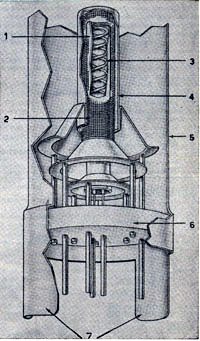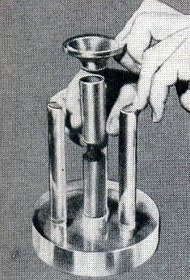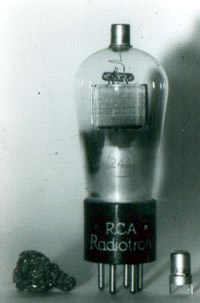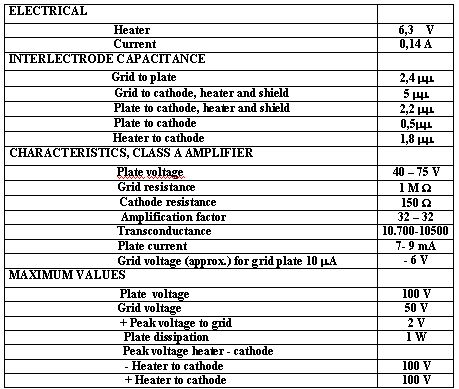10.4 - THE NUVISTOR
THE DECLINE OF THE THERMIONICS
THE DECLINE OF THE THERMIONICS
| In
1960, Radio Corporation of America launched in the world market a
new type of thermionic valve made in ceramic material, rather than
the classic glass and mica components. Such new valve was very small
in size circa 2 cm and was christened as NUVISTOR. This kind of thermionic device was an effort of the electronic industry to compete with the then-blossoming TRANSISTOR, whose development started in 1955 under the surpevision of George Rose working at RCA research laboratories. It was known by the valve industry from the beginning that the valves dimensions were oversized since the manufacturing process was dependent of the available technology. In this way, when a valve structure is proportionally scaled down in size, some characterisitics remain constant, others improve, and still others degenerate. For example, while the mutual transconductance and plate resistance remain substantially the same, the cathode efficiency and high frequency performance improve. By other hand cathode current density, however, increases and the grid and plate operate at much higher temperatures tend to act adversely on the valve life and reliability. Thus, it was discovered if the valve inner elements were spaced down these side effects could be offset and in the same time the use of much lower electrodes voltage could improve even more the cathode life, as well as reducing the high-voltage insulation required in the valve, the socket, and associated circuit elements. This differential scaling made possible also more efficient thermal eviroment among the valve inner elements. Thus while the heat should be kept between the cathode and its frame assembly, it is very important that the grid and the plate should be made of high thermal conductivity materials to stay cool and in the same time avoiding the production of gases. The NUVISTOR revolutionized the art of valve making by minimizing or even eliminating the defects that had plague the industry in such away it became "state of art". During the researches many technologies were investigated. For example: the planar, cylindrical and ceramic spaced stacked structures; metal-to-glass seals, metal-to-ceramic seals. Finally the cylindrical concetric open-ended cantilever configuration was selected which allowed for ease and simplicity of construction and readily lent itself to miniaturization. Fig 265 In the valve construction, the electrodes made into a small, light cylinders comprising a conical strucuture were assembled in ceramic base-wafer. Materials and techniques generally used in valve manufacturing like glass and mica as well as spot-welding were eliminated. Fig 266 Such a kind of design using a sturdy metal-ceramic strucuture gave birth to a small, light and reliable thermionic device. A full family of NUVISTORS was launched in the market, including single and double-ended triodes, double-ended diodes, triodes, tetrodes and finally as 5 Watt pentode. The valve main electrical characteristcs are indicated in the table. Fig 267 NUVISTOR was used for many industrial applications including civilian and military purposes and it was mainly responsible for the success of the RCA TV color sets in the early sixties. Later in 1961 RCA production rate was greatly increased reaching 1 milion units until its plant closed in 1976. Fig 268 Certainly NUVISTOR was a step ahead in the valve manufacturing technology and after almost 20 years in the market as a direct competitor for the TRANSISTOR, its industrial production ceased when Sylvania closed its plant in 1980 due to the boom of the solid-state domain.
|



